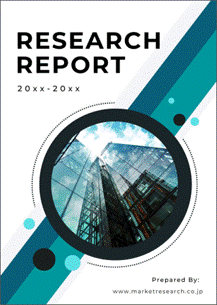 | • レポートコード:MRC2303N043 • 出版社/出版日:Mordor Intelligence / 2023年1月23日 • レポート形態:英文、PDF、154ページ • 納品方法:Eメール(受注後2-3営業日) • 産業分類:農業 |
| Single User | ¥688,750 (USD4,750) | ▷ お問い合わせ |
| Corporate License | ¥1,268,750 (USD8,750) | ▷ お問い合わせ |
• お支払方法:銀行振込(納品後、ご請求書送付)
レポート概要
| Mordor Intelligence社では、世界の殺菌剤市場規模は予測期間中(2022-2027年)に年平均3.8%成長すると予測しています。本調査レポートでは、殺菌剤の世界市場について総合的に調査・分析し、イントロダクション、調査手法、エグゼクティブサマリー、市場動向、由来別(合成樹脂、バイオベース、その他)、作物別(穀物、油糧種子&豆類、果物&野菜、芝生&観葉植物、その他)分析、地域別(アメリカ、カナダ、メキシコ、スペイン、イギリス、フランス、ドイツ、ロシア、イタリア、中国、日本、インド、オーストラリア、ブラジル、アルゼンチン、南アフリカ)分析、競争状況、市場機会・将来の動向、新型コロナウイルス感染症影響分析などの内容でまとめております。なお、当書に掲載されている企業情報には、ChemChina Corporation、American Vanguard Corporation、BASF SE、Bayer Cropscience AG、Bioworks Inc.、Corteva Agriscience、FMC Corporation、Isagro Spa、Marrone Bio Innovations Inc.、Nippon Soda Co. Ltd、Nufarm Ltd、Sumitomo Chemical、UPL Limitedなどが含まれています。 ・イントロダクション ・調査手法 ・エグゼクティブサマリー ・市場動向 ・世界の殺菌剤市場規模:由来別 - 合成樹脂殺菌剤の市場規模 - バイオベース殺菌剤の市場規模 - その他由来の市場規模 ・世界の殺菌剤市場規模:作物別 - 穀物の市場規模 - 油糧種子&豆類の市場規模 - 果物&野菜の市場規模 - 芝生&観葉植物の市場規模 - その他作物の市場規模 ・世界の殺菌剤市場規模:地域別 - 北米の殺菌剤市場規模 アメリカの殺菌剤市場規模 カナダの殺菌剤市場規模 メキシコの殺菌剤市場規模 … - ヨーロッパの殺菌剤市場規模 スペインの殺菌剤市場規模 イギリスの殺菌剤市場規模 フランスの殺菌剤市場規模 … - アジア太平洋の殺菌剤市場規模 中国の殺菌剤市場規模 日本の殺菌剤市場規模 インドの殺菌剤市場規模 … - 南米の殺菌剤市場規模 ブラジルの殺菌剤市場規模 アルゼンチンの殺菌剤市場規模 … - 中東の殺菌剤市場規模 南アフリカの殺菌剤市場規模 GCC諸国の殺菌剤市場規模 … - その他地域の殺菌剤市場規模 ・競争状況 ・市場機会・将来の動向 ・新型コロナウイルス感染症影響分析 |
The fungicide market is anticipated to record a CAGR of 3.8% during the forecast period (2022-2027).
The COVID-19 pandemic forced many companies in the fungicide market to halt their business operations to comply with the new government rulings. This halt in operations is directly impacting the revenue of the fungicide market. Manufacturers were affected by the supply chain block of raw materials and intermediates due to COVID-19. The cost of logistics increased quickly during the initial months of the pandemic. Thus, the ongoing COVID-19 pandemic compelled the companies to rethink their strategies in the industry.
Factors driving the market for fungicides include decreasing arable land, increasing population, and the need to improve crop yields. Resistance of various fungi to the existing fungicides and the emergence of new diseases in plants led the companies to find novel products for fighting the new mutations of fungus and reducing the loss to farmers. The increasing demand for fungicides to fight the diseases in crops is expected to drive the market during the forecast period.
Regulatory authorities such as the EPA (Environment Protection Agency) frequently introduce stringent laws related to curbing pesticide use to alleviate environmental damage and increase consumer awareness about pesticide consumption. Such factors are expected to be instrumental in slowing down the demand for fungicides.
Fungicide Market Trends
Increasing Demand from Developing Countries
As per the Food and Agriculture Organization, the total arable land for cereals, pulses, fruits, and vegetables is increasing every year, presenting opportunities for the farmers to meet the increasing domestic and international food demand. Hence, to protect their crops against various fungal infestations, farmers are adopting the usage of fungicides. Over the last few years, several factors have shifted the demand for fungicides from developed to developing regions. Fungicide sales account for more than 40% of the total pesticide sales in the European Union, with synthetic and organic fungicides accounting for approximately 60% of all fungicides. Fungicides can account for more than 90% of all pesticide applications in wine-growing regions. The United States represents 80% of the total fungicide use in North America. In addition to endeavors aimed at restricting unnecessary utilization of fungicides, the industrial markets of North America, Western Europe, and Japan are likely to sustain below-average growth in the demand for fungicides over the coming half-a-decade, due to maturity in the markets.
Asia-Pacific Dominates the Market
Asia-Pacific is among the largest consumer of fungicides in the market. During the study period, there was increased investment in R&D for manufacturing novel, innovative, and cost-efficient solutions against fungi in crops in the region. The high production potential for grains, cereals, and vegetables in the region increased the demand for fungicides in the market. Fungicides, especially SDHI fungicides, are often used in combination with other chemicals and are widely used for seed treatments in the region. For instance, Carboxin is often used with thiram for seed treatment of various crops, such as soybean, groundnut, cotton, and potato.The increased demand for food among the growing population can be attributed to the need to enhance crop yield.
Fungicide Market Competitor Analysis
The fungicide market is consolidated, with major companies occupying most of the market. Major companies include UPL Ltd, BASF SE, Bayer CropScience, FMC Corp., Syngenta AG, and Valent Biosciences. The key strategies used by companies in the market are new product registrations and acquisitions to enter new markets. The focus in the industry should be on integrated pest management techniques and sustainable practices for an improved yield without harming the environment.
Additional Benefits:
- The market estimate (ME) sheet in Excel format
- 3 months of analyst support
1 INTRODUCTION
1.1 Study Assumptions and Market Definition
1.2 Scope of the Study
2 RESEARCH METHODOLOGY
3 EXECUTIVE SUMMARY
4 MARKET DYNAMICS
4.1 Market Overview
4.2 Market Drivers
4.3 Market Restraints
4.4 Porter’s Five Forces Analysis
4.4.1 Threat of New Entrants
4.4.2 Bargaining Power of Buyers
4.4.3 Bargaining Power of Suppliers
4.4.4 Threat of Substitute Products
4.4.5 Intensity of Competitive Rivalry
5 MARKET SEGMENTATION
5.1 Origin
5.1.1 Synthetic
5.1.2 Bio Based
5.1.3 Other Originss
5.2 Crop Type
5.2.1 Cereals and Grains
5.2.2 Oilseeds and Pulses
5.2.3 Fruits and Vegetables
5.2.4 Turf and Ornamentals
5.2.5 Other Crop Types
5.3 Geography
5.3.1 North America
5.3.1.1 United States
5.3.1.2 Canada
5.3.1.3 Mexico
5.3.1.4 Rest of North America
5.3.2 Europe
5.3.2.1 Spain
5.3.2.2 United Kingdom
5.3.2.3 France
5.3.2.4 Germany
5.3.2.5 Russia
5.3.2.6 Italy
5.3.2.7 Rest of Europe
5.3.3 Asia-Pacific
5.3.3.1 China
5.3.3.2 Japan
5.3.3.3 India
5.3.3.4 Australia
5.3.3.5 Rest of Asia-Pacific
5.3.4 South America
5.3.4.1 Brazil
5.3.4.2 Argentina
5.3.4.3 Rest of South America
5.3.5 Middle-East
5.3.5.1 South Africa
5.3.5.2 Rest of Middle-East
6 COMPETITIVE LANDSCAPE
6.1 Market Share Analysis
6.2 Most Adopted Strategies
6.3 Company Profiles
6.3.1 ChemChina Corporation
6.3.2 American Vanguard Corporation
6.3.3 BASF SE
6.3.4 Bayer Cropscience AG
6.3.5 Bioworks Inc.
6.3.6 Corteva Agriscience
6.3.7 FMC Corporation
6.3.8 Isagro Spa
6.3.9 Marrone Bio Innovations Inc.
6.3.10 Nippon Soda Co. Ltd
6.3.11 Nufarm Ltd
6.3.12 Sumitomo Chemical
6.3.13 UPL Limited
7 MARKET OPPORTUNITIES AND FUTURE TRENDS
8 IMPACT OF COVID-19 ON THE MARKET
